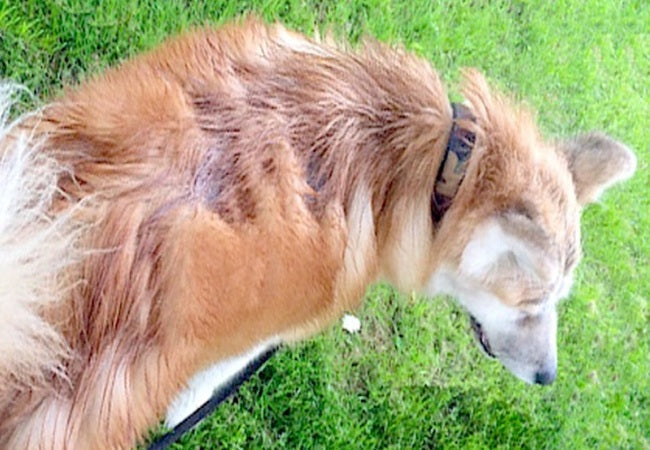Vet’s 2025 Guide to Sebaceous Adenitis in Dogs 🩺 Causes, Diagnosis & Lifelong Management

In this article
Vet’s 2025 Guide to Sebaceous Adenitis in Dogs 🩺 Causes, Diagnosis & Lifelong Management
By Dr. Duncan Houston BVSc
💡 What Is Sebaceous Adenitis?
Sebaceous adenitis is an inflammatory, likely immune-mediated, destruction of sebaceous glands that leads to scaling, brittle hair, and hair loss. It predominately affects breeds such as Standard Poodles, Akitas, Vizslas, Samoyeds, and others.
🌍 Who’s at Risk & What Causes It?
- Breeds predisposed: Standard Poodles, Akitas, Samoyeds, Vizslas, Belgian Sheepdogs, Dachshunds, and more—autosomal recessive inheritance in some breeds.
- Age of onset: Usually young adults (1–6 years).
- Rare in short-coated dogs: may present as patches of hair loss and scaling.
🚩 Clinical Signs & Presentation
- Long-coated breeds: silvery scales adherent to hair (“follicular casts”), brittle coat, dull appearance, bilateral dorsal scalp and tail involvement.
- Short-coated breeds: patchy “moth-eaten” hair loss, fine scaling, alopecic areas.
- Secondary bacterial infections: pruritus, odor, crusting; especially in Akitas.
- Often non‑painful, but may cause discomfort when pyoderma is present.
🧪 Diagnosis
- Cytology & scrapings: to rule out mites, yeast, bacteria.
- Skin biopsy: gold standard—confirms loss of sebaceous glands and granulomatous inflammation.
- History & exam: breed, age, bilateral dorsal scaling; must exclude Cushing’s, allergies, dermatophytosis.
🩺 Treatment & Management Strategies
There is no cure—management is lifelong and focuses on scaling control, skin barrier support, and immunomodulation.
1. Topical Therapy & Baths
- Frequent antiseborrheic bathing (3–4×/week) with sulfur/salicylic acid shampoos.
- Mineral oil or propylene glycol soaks (1–2 hours) followed by baths for scale removal.
- Emollient sprays and leave-on moisturizing products to restore barrier function.
2. Systemic Immunomodulators
- Cyclosporine ~5 mg/kg/day—supported as most effective; may be combined with topical therapy for synergy.
- Corticosteroids may help acutely when intense inflammation or itching arises but are not first-line chronically.
3. Adjunctive Supplements & Medications
- Vitamin A (1,000 IU/kg/day)—used for skin health.
- Here's why omega-3 & omega-6 fatty acids help barrier repair and reduce inflammation.
- Tetracyclines (doxycycline/minocycline) at 5 mg/kg PO q12h—exhibit anti-inflammatory rather than antibiotic effects.
4. Lifelong Monitoring & Compliance
- Ongoing monthly rechecks early, then every 3–6 months, depending on disease stability.
- Bloodwork for dogs on cyclosporine, retinoids, or long-term steroids—check liver, kidneys, tear tests (STT).
- Expect variable response—many show significant improvement within 3–4 months, but relapses are common without maintenance.
📈 Prognosis & Quality of Life
- Chronic but manageable; not life-threatening.
- Many dogs regain hair and coat condition with long-term treatment.
- Severe cases with recurrent infections need vigilant care and may remain symptomatic.
- Lifelong commitment is essential to maintain skin health and minimize cosmetic changes.
🚫 Breeding & Prevention
- Hereditary in predisposed breeds—affected dogs should not be bred.
- No DNA tests available—use phenotype screening and regular veterinary exams.
- Avoid exposure to triggers like harsh detergents, allergens, maintain healthy skin care.
🏡 Ask A Vet Home‑Care Support
- 🗓 Reminders: bath schedules, topical soaks, medication dosing, vet check-ins.
- 📸 Photo tracking: scaling, coat texture, progress or relapse.
- 📊 Symptom logs: itch level, odor, hair density, coat sheen.
- 🔔 Alerts: flares, infection signs, medication side effects (e.g., lethargy, appetite loss).
- 📚 Resources: tutorials on soak/bath techniques, supplement guides, infection warning signs.
🔑 Key Takeaways
- Sebaceous adenitis = immune destruction of sebaceous glands → scaling, brittle coat, alopecia.
- Diagnosis: biopsy confirmation after excluding similar dermatological disorders.
- Care: frequent topical therapy, immunomodulation (cyclosporine), supplementation, and regular monitoring.
- Prognosis: manageable with early and consistent treatment; lifelong follow-up needed.
- Breeding discouraged; Ask A Vet app provides structure, reminders, and remote vet support.
🩺 Final Thoughts ❤️
In 2025, managing sebaceous adenitis focuses on early detection, comprehensive skin and immune care, and dedicated at-home support. With modern topical protocols, immunomodulators, dietary supplements, and consistent vet follow-ups, many dogs achieve a healthy coat and quality of life. The Ask A Vet app empowers owners to track baths, monitor progress, log symptoms, and communicate with their veterinary team—making chronic skin care simpler and effective. 🐾✨
Visit AskAVet.com and download the Ask A Vet app to schedule treatments, log your dog’s symptom photos, set medication reminders, track lab test dates, and stay connected with your vet—all from your phone. 📲






